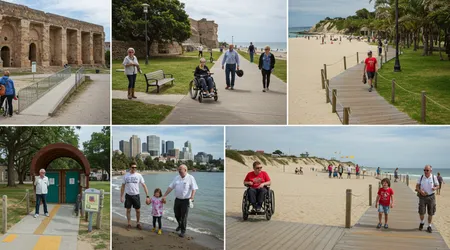Accessible Tourism and Public Policy: From Vision to Regulation

Rights and public policies shape the future of accessible tourism, ensuring inclusivity for all travelers. Imagine a world where every destination welcomes everyone, regardless of physical or cognitive limitations.
This vision drives global efforts to transform tourism into a truly inclusive experience. From bustling city centers to serene natural parks, the call for accessibility resonates louder in 2025 than ever before.
Governments, organizations, and businesses are aligning to create regulations that not only comply with international standards but also inspire meaningful change.
This article explores how rights and public policies evolve from aspirational goals to actionable frameworks, weaving together innovation, empathy, and accountability to make travel a universal right.
The journey toward accessible tourism isn’t just about ramps or braille signs; it’s about dignity, equity, and opportunity.
The United Nations’ 2030 Agenda for Sustainable Development emphasizes inclusive tourism as a cornerstone of social equality, with Sustainable Development Goals (SDGs) 10 and 11 explicitly addressing reduced inequalities and sustainable cities.
In 2025, the urgency to implement these goals has intensified, spurred by a growing global population of people with disabilities 1.3 billion, according to the World Health Organization.
This demographic, often accompanied by companions, represents a significant economic opportunity, with accessible tourism generating millions in revenue annually.
Yet, barriers persist, from inaccessible websites to inadequate infrastructure, underscoring the need for robust rights and public policies.
This article delves into the policies shaping this landscape, offering insights, examples, and a vision for a more inclusive future.
The Moral and Economic Imperative of Accessibility
Why should travel be a privilege for some and a struggle for others? Accessibility in tourism isn’t just a moral obligation; it’s a business opportunity.
The UN World Tourism Organization (UNWTO) estimates that travelers with disabilities, often traveling with companions, contribute significantly to global tourism revenue.
In 2023, the International Accessible Tourism Forum in Seoul highlighted that this market could tap into a 1.3 billion-person demographic, amplifying economic benefits for destinations that prioritize inclusivity.
Yet, moral and economic drivers often clash with practical challenges. Many destinations lack the infrastructure to accommodate diverse needs, from wheelchair-accessible transport to sensory-friendly environments.
Rights and public policies must bridge this gap, ensuring that accessibility isn’t an afterthought but a priority.
++ Disability in Healthcare Policy: Where Equity Still Falls Short
For example, Spain’s ONCE Foundation has partnered with UNWTO to develop accessibility guidelines, showing how collaboration can turn vision into reality.
Policy frameworks like the UN Convention on the Rights of Persons with Disabilities (CRPD), adopted in 2006, set a global standard.
By 2025, 165 countries have ratified it, committing to inclusive practices. However, implementation varies.
While Europe advances with the European Accessibility Act (EAA), effective June 2025, other regions lag, leaving travelers with disabilities facing inconsistent experiences.

From International Guidelines to Local Action
Global frameworks provide a blueprint, but local action brings change. The EAA, for instance, mandates that e-commerce platforms, including tourism websites, meet Web Content Accessibility Guidelines (WCAG) 2.1 by mid-2025.
This ensures that travelers with visual or cognitive impairments can access information seamlessly. Cities like Barcelona have embraced this, offering accessible digital guides for tourists.
Contrast this with regions where policy enforcement is weak. In some developing nations, budget constraints and lack of awareness hinder progress.
Rights and public policies need local champions governments, NGOs, and businesses that adapt global standards to regional realities.
Also read: Why Workplace Inclusion Laws Aren’t Working (And What Needs to Change)
For instance, Costa Rica’s accessible ecotourism initiatives, like wheelchair-friendly trails in national parks, show how local innovation can align with global goals.
Training is another critical piece. Tourism professionals must understand diverse needs, from autism-friendly certifications to sign language services.
South Korea’s 2023 forum emphasized training programs that empower staff to create inclusive experiences, proving that human connection is as vital as infrastructure.
Technology as a Catalyst for Inclusion
Technology is a game-changer for accessible tourism. Imagine a visually impaired traveler using a smartphone app to navigate a museum with audio descriptions.
Apps like AccessNow map accessible venues worldwide, empowering users with real-time data. Yet, technology’s potential hinges on rights and public policies that mandate its adoption.
The EAA’s focus on digital accessibility is a step forward. By June 2025, tourism businesses in the EU must ensure websites and apps meet WCAG standards, reducing barriers like non-captioned videos or complex navigation.
Read more: What Disability Rights Look Like in Developing Countries
In practice, this means companies like Booking.com are revamping platforms to include accessibility filters, allowing users to find hotels with roll-in showers or braille menus.
However, technology isn’t a cure-all. Rural destinations often lack the infrastructure for high-tech solutions, and not all travelers have access to smartphones.
Policies must balance innovation with low-tech solutions, like tactile maps or trained guides, to ensure no one is left behind.
| Policy Framework | Region | Key Requirement | Implementation Date |
|---|---|---|---|
| European Accessibility Act | EU | WCAG 2.1 compliance for digital platforms | June 28, 2025 |
| UN CRPD | Global | Accessibility in public services, including tourism | 2006 (ongoing) |
| ADA | USA | Accessible public accommodations | 1990 (updated 2025) |
The Role of Stakeholder Collaboration
No policy succeeds without collaboration. Governments, businesses, and disability advocacy groups must work together to turn vision into reality.
The UNWTO’s 2014 San Marino Conference on Accessible Tourism showcased this, uniting stakeholders to develop actionable recommendations. In 2025, such collaborations are more critical than ever.
Take Australia’s example: its tourism board partners with disability organizations to certify accessible destinations, like Sydney’s wheelchair-friendly Opera House tours.
This synergy ensures that rights and public policies reflect real-world needs. Businesses benefit too, gaining credibility and tapping into a growing market.
Yet, collaboration faces hurdles. Small businesses, especially in rural areas, often lack resources to implement accessibility measures.
Public policies must offer incentives, like tax breaks or grants, to ease this burden. Japan’s Accessible Tourism Promotion Platform provides a model, subsidizing small hotels to install ramps and train staff.
Challenges in Policy Implementation
Turning vision into regulation isn’t seamless. Enforcement gaps, funding shortages, and cultural attitudes often stall progress.
In some countries, rights and public policies exist on paper but lack teeth. For example, while the CRPD mandates accessibility, many signatories struggle with compliance due to limited oversight.
Cultural perceptions also matter. In regions where disability is stigmatized, policies may be ignored. Advocacy groups play a vital role here, pushing for awareness and accountability.
The European Network for Accessible Tourism (ENAT) has been instrumental in training businesses and auditing compliance, showing how grassroots efforts can bolster policy.
Economic constraints are another hurdle. Retrofitting historic sites, like Rome’s Colosseum, for accessibility is costly.
Policies must balance preservation with inclusion, offering creative solutions like virtual tours or temporary ramps to ensure access without compromising heritage.
Empowering Travelers Through Policy
Empowering travelers means giving them a voice. Rights and public policies should prioritize co-production, involving people with disabilities in policy design.
The Gargano National Park in Italy, for instance, uses social network analysis to ensure disability associations shape tourism policies, fostering inclusive communication.
Feedback mechanisms are equally vital. Travelers must have platforms to report accessibility issues, like TripAdvisor’s accessibility reviews.
Policies should mandate such tools, ensuring accountability. In 2025, apps like Wheelmap allow users to rate venues, driving businesses to improve.
Education campaigns also empower travelers. By raising awareness of their rights, policies can encourage self-advocacy.
The UNWTO’s 2023 guidelines urge governments to fund campaigns that inform travelers about accessible options, building confidence and trust.
The Future of Accessible Tourism Policies

Looking ahead, rights and public policies must evolve with emerging trends. Climate change, for instance, affects accessible tourism, as extreme weather can disrupt infrastructure like ramps or elevators.
Policies must integrate resilience, ensuring accessibility withstands environmental challenges.
Artificial intelligence (AI) offers new possibilities. AI-driven chatbots can provide real-time accessibility information, while predictive analytics can help destinations plan inclusive infrastructure.
However, policies must ensure AI tools are accessible themselves, avoiding new barriers.
Global cooperation will define the future. The UNWTO’s 2025 ITB session on inclusive employment in tourism highlights the need for cross-border strategies.
By sharing best practices, countries can create a global standard for accessible tourism, making travel truly universal.
Conclusion: A Call to Action
Accessible tourism is more than a policy goal; it’s a commitment to human dignity. Rights and public policies are the scaffolding that turns vision into reality, ensuring every traveler can explore the world freely.
From the EAA’s digital mandates to local initiatives like Costa Rica’s accessible trails, progress is tangible but incomplete. The 1.3 billion people with disabilities deserve more than promises they deserve action.
Stakeholders must unite, blending innovation, empathy, and accountability to dismantle barriers. Let’s build a world where travel is a right, not a privilege, and where every journey is inclusive.
Frequently Asked Questions
What is the European Accessibility Act, and how does it impact tourism?
The EAA, effective June 2025, mandates that digital platforms, including tourism websites, meet WCAG 2.1 standards, ensuring accessibility for all travelers.
How can small businesses comply with accessibility policies?
Small businesses can access grants, partner with disability organizations, and implement low-cost solutions like staff training or digital accessibility tools.
Example 1: Maria’s Journey
Maria, a wheelchair user, explored Costa Rica’s Arenal Volcano National Park using its accessible trails, designed with input from disability advocates.
Example 2: Virtual Access
Rome’s Colosseum offers virtual tours with audio descriptions, allowing visually impaired travelers to experience its history without physical barriers.
Analogy
Accessible tourism is like a bridge: sturdy policies connect travelers to destinations, ensuring everyone can cross without falling through the gaps.
Statistic
The UNWTO notes that travelers with disabilities contribute to 170 million day trips annually in the EU, highlighting their economic impact.
